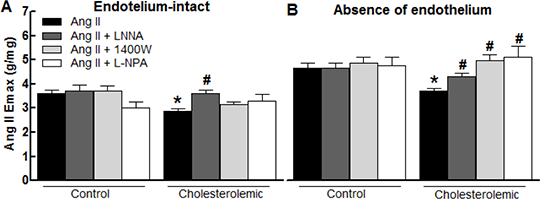Print version
Search Pub Med
Early Stage of Hypercholesterolemia Induces Changes in Vascular Reactivity to Angiotensin II in Thoracic Arteries from Hamsters Emerging evidences support the idea that there is cross-talk between hypercholesterolemia and renin-angiotensin system (RAS) in atherogenesis (1). Hypercholesterolemia in advanced stages enhances RAS activity (2). However, the effect this interaction has on vascular reactivity stages of hypercholesterolemia has remained unexplored. The objective was to evaluate whether hypercholesterolemia in its initial stages induces change in vascular reactivity to angiotensin II (Ang II), and whether such changes are related to metabolites derived from nitric oxide synthase (NOS). Adults male Golden Syrian hamsters (n≥5) were fed with standard diet control group (C) or standard diet + 1% cholesterol for 15 days (CH). Concentration-response curves for Ang II were obtained from endothelium-intact (+E) or absence of endothelium (-E) thoracic aorta rings, in the absence or presence of the selective NOS isoforms inhibitors, eNOS (L-NNA, 100µmol/L), iNOS (1400W, 10nmol/L) and nNOS (L-NPA, 50 nmol/L). Nitric oxide levels were measured by confocal microscopy in thoracic aorta loaded with the fluorescent dye, DAF2DA (10µmol/L) before and after Ang II addition (0.1 mmol/L). The intake of a cholesterolemic diet reduced the maximum effect (Emax) for Ang II in CH hamsters +E (Fig. 1A) and -E (Fig. 1B) arteries compared to C. In CH +E arteries, the eNOS inhibitor increased Emax for Ang II when compared to absence of the inhibitor. In -E, all selective inhibitors of NOS isoforms increased the Ang II Emax in CH arteries in relation to respective C. The fluorescence intensity (FI) basal levels stimulated with Ang II were reduced in CH arteries when compared to respective C. In the presence of L-NNA, a reduction was observed in the FI from C group in relation to absence of this inhibitor (Fig. 2). 
Fig. 1 Effect of NOS inhibitors on Ang II Emax in thoracic arteries from control and cholesterolemic hamster. *p<0.05 vs. respective control. #p<0.05 vs. cholesterolemic in absence of inhibitors. Anova one-way; Bonferroni. n≥8. 
Fig. 2 Effect of hypercholesterolemia on the NO levels. *p<0.05 vs. respective control. #p<0.05 vs. control in absence of inhibitors. Anova one-way; Bonferroni. n=5. The hypercholesterolemia in initial stages reduces the contraction of Ang II due to the participation of endothelium-independent relaxant metabolites derived from NOS and it does not seem to be a direct effect of NO. However, NO-derived metabolites might be responsible for this response. In conclusion, the hypercholesterolemia seems to lead to a time-dependent modulation on RAS: in early stages a reduction of vascular reactivity to Ang II occurs, unlike that which occurs in later stages. (1) Koh KK, et al., Atherosclerosis 209(2):307-313, 2010 (2) Singh BM & Mehta JL, Arch Intern Med 163:1296-1304, 2003
|



